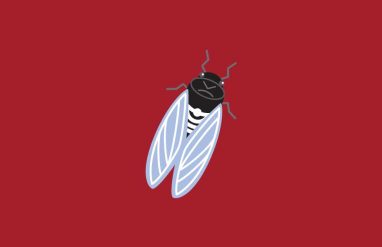There has been a lot of buzz around cicadas recently—you’ve probably heard about Brood X by now (if not, read on). But do you know what a cicada actually is? Are they the same as locusts? Are they all just a kind of grasshopper?
Telling cicadas and locusts apart can be a bit complicated, especially since the words are sometimes used interchangeably and the particularly buzzed-about type of cicada is alternately called a periodical cicada, a seventeen-year cicada, or a seventeen-year locust.
In many cases, though, the terms refer to two types of insects with major differences, including their body parts and shape, their behavior, and their life cycle.
Hop on board for this insect journey, and we promise you’ll see the distinctions start to emerge.
⚡️Quick summary
Cicadas are known for their regular emergence—annually or in cycles of 13 or 17 years—and their ability to produce a distinct, buzzy, droning sound. Locusts are a type of grasshopper known for sometimes traveling in swarms and devouring plant life on a large scale. Still, cicadas are sometimes referred to as locusts.
What is a cicada?
Many more periodical cicada (Magicicada septendecim) this evening—thanks to @CharIaRepIogIe & @Ryan_Lumen for a great hike! pic.twitter.com/AobnWxQ191
— Chris Wirth (@AgeOfArthropods) May 27, 2021
A cicada is “any large homopterous insect of the family Cicadidae, the male of which produces a shrill sound by means of vibrating membranes on the underside of the abdomen.” So, they’re big insects that can make a lot of noise. And they’re found all over the world, so there’s a good chance you’ve heard it.
The unique life cycle of cicadas involves the nymphs (the young that have yet to metamorphose, or transform, into their adult form) living underground for a period of time before emerging to mate. Most cicadas are called annual cicadas, meaning some come out of the ground each year in the summer. But in the Eastern United States, there’s a special type called periodical cicadas that emerge after 13 or 17 years! This generally happens in springtime, around May, when the ground is fully thawed. In the summer of 2021, a large (like, billions large) emergence of 17-year periodic cicadas occurred (as part of a group known as Brood X, with X signifying the Roman numeral for 10).
At a certain point, they shed their exoskeleton, leaving behind an empty shell. Their life cycle ends when the insects die just about four to six weeks after emerging.
Crawl deeper into the meanings behind different insect names and terms, here.
What is a locust?
Kenya On High Alert As Fresh Wave of Locust Invasion Looms @The_EastAfrican: https://t.co/LcKFnAaXXC #Kenya pic.twitter.com/WKh6oZjm1Y
— allAfrica.com (@allafrica) May 28, 2021
A locust is “any of several grasshoppers of the family Acrididae, having short antennae and commonly migrating in swarms that strip the vegetation from large areas.”
The term is used differently in different places. Sometimes, it refers to smaller grasshoppers. In North America, the words locust and grasshopper are often used interchangeably, with locust less commonly applied to cicadas.
In Africa and Asia particularly, the term locust refers to the type of grasshopper known for swarming and destroying almost any vegetation in their path, including crops. When environmental conditions turn bad, these locusts turn social and migrate. This migration is often called a swarm (or sometimes a plague).
What’s the difference between locusts vs. grasshoppers?
Grasshoppers are herbivorous (plant-eating) insects with hind legs that make them great at leaping and mouth parts that make them good at chewing. Most grasshoppers live their lives in a solitary fashion, peacefully chomping down vegetation wherever it’s found and living their lives in one area. Simply stated, a locust is a specific type of grasshopper that, under certain conditions, transitions from being a solitary insect to one that will travel in destructive swarms. The term locust is generally applied to any kind of swarming grasshopper.
Grasshopper vs. cricket
Crickets are often confused with grasshoppers and with good reason. They’re both orthopterous, or part of the insect order known as Orthoptera, but they belong to different suborders within this group. (So if locusts are a type of grasshopper, crickets are in a different suborder than both.)
Both crickets and grasshoppers stridulate or produce sound with their bodies. However, crickets rub their legs together, while grasshoppers rub their legs on their wings. An easy way to tell them apart by looking at them is to check their antennae: crickets can have much longer antennae than grasshoppers.
How to tell cicadas, locusts, and grasshoppers apart
Cicadas, locusts, and grasshoppers are all herbivorous winged insects with some ability to make noise.
Cicadas have big, clear wings and a rounded body. Locusts are a bit smaller and have a slim, straight body, with big hind legs for leaping.
Cicadas are known for the distinctive loud sound that they make. Locusts can produce noise by rubbing their wings together or against their bodies, but the sound doesn’t compare to that created by large numbers of cicadas droning together in chorus.
These different kinds of insects are most set apart by their behavior and life cycle. Locusts are known for sometimes swarming and devouring all plant life in their path. Cicadas are also known for emerging in large numbers, but not for swarming from area to area or widespread destruction of plants. Cicadas are especially known for their regular, periodical emergences, which is not the case for locusts.
Less commonly, the word locust is used for any cicada. The specific term seventeen-year locust refers to what’s more commonly called a cicada (or a seventeen-year cicada). The term periodical cicada can also refer to the 13-year kind.
Locusts are a specific type of grasshopper. Insects called grasshoppers are usually green, yellow, or brown, while those referred to as locusts are often brown, yellow, or black. Locusts tend to have shorter antennae than other grasshoppers. Grasshoppers tend to be solitary—the swarming kind are generally referred to as locusts.
Examples of cicada, locust, and grasshopper used in a sentence
Here are some of the ways you might see cicada, locust, and grasshopper used in sentences out in the wild:
- To me, the drone of cicadas sounds like summer.
- This year, a brood of 13-year periodical cicadas will emerge, in addition to the kind that emerge annually.
- Eastern African countries are seeing an increase in devastating swarms of locusts thought to be driven by climate change.
- That green guy there is a grasshopper—the swarming kind that we call “locusts” are usually more brownish yellow.














